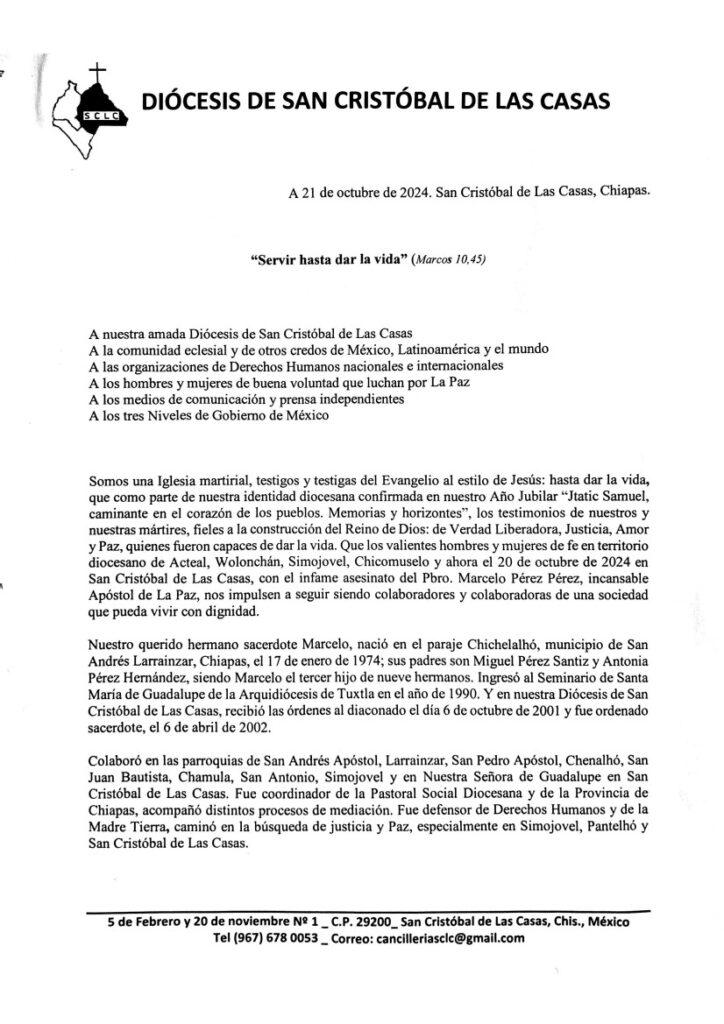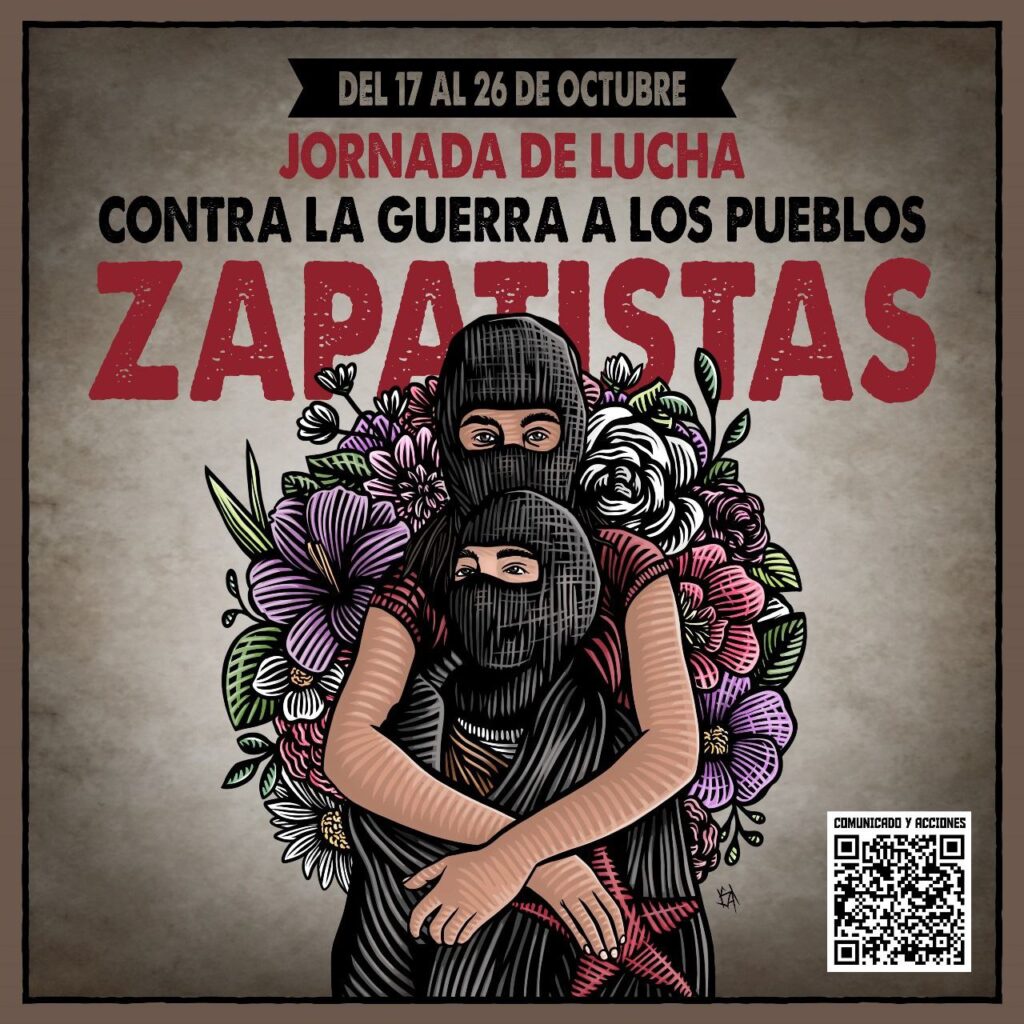
Mexico
Entrevista audiovisual al sacerdote indígena Marcelo Pérez Pérez
Fuente: VocesenLucha
ENTREVISTA AUDIOVISUAL AL SACERDOTE INDÍGENA MARCELO PÉREZ PÉREZ
Por Vocesenlucha
«El reino de los cielos es la vida digna aquí en la tierra, aquí. El reino de Dios es vivir dignamente. Es la paz, es la justicia, es la libertad, es el gozo interior, es tener lo necesario para vivir, es que la madre tierra viva feliz también, ese es el reino de Dios para mí, que la mujeres no sean maltratadas por ser mujeres»
Hace unos días el periodista mexicano Luis Hernández Navarro escribía un artículo en La Jornada titulado «Chiapas, la guerra civil llama a la puerta», donde afirma que este territorio histórico zapatista hoy «es un polvorín. Secuestros, asesinatos, amenazas de muerte y bloqueos se extienden por todo el territorio».
El pasado domingo 20 de octubre, el padre Marcelo Pérez fue asesinado por unos sicarios cuando salía de oficiar misa en una iglesia del barrio de Cuxtitali, San Cristóbal de las Casas, Chiapas, México.
El sacerdote tzotzil formaba parte de la Pastoral Social y del Pueblo Creyente, movimiento popular de defensa por la vida y el territorio que conocimos de primera mano en 2020, y que se inserta en la tradición latinoamericana de la teología de la liberación, liderada en la zona por el histórico obispo de Chiapas Samuel Ruíz, «Tatik», defensor de los derechos de los pueblos indígenas fallecido en 2011.
El padre Marcelo se enfrentó sin miedo al crimen organizado en diferentes territorios de Chiapas donde desarrolló su labor pastoral, señalando los vínculos de estos grupos con autoridades y cargos públicos. Producto de eso recibía desde hace años amenazas de muerte.
Compartimos esta extensa entrevista audiovisual que tuvimos el honor de realizarle a este extraordinario sacerdote indígena en San Cristóbal de las Casas, cuando era párroco de Simojovel y coordinador de la Pastoral Social de la provincia de Chiapas. Conversamos sobre la Iglesia y la vocación por las y los oprimidos, las amenazas a su persona por parte del crimen organizado y el narcotráfico, la defensa del territorio y la madre tierra; crisis, revolución y lucha armada, el zapatismo, Acteal, la vinculación entre fe y política y sobre dignidad.
«Al defender la vida, queda amenazada la vida. Nuestra vida siempre está llamada para defender la otra vida. No tendrá ningún sentido mi vida si no es ponerla al servicio de los demás».Padre Marcelo
Hasta «el reino de los cielos aquí en la tierra» siempre, querido compañero.
Las Abejas de Acteal: A pesar del atroz crimen cometido en contra del Padre Marcelo, nuestra esperanza no se rinde. ¡YA BASTA! DE DESTRUCCIÓN Y EXTERMINIO.
Organización Sociedad Civil Las Abejas de Acteal
Tierra Sagrada de los Mártires de Acteal
Acteal, Chenalhó, Chiapas, México.
22 de octubre 2024
Al Congreso Nacional Indígena
Al Consejo Indígena de Gobierno
A la Comisión Interamericana de Derechos Humanos
A las y los Defensores de los Derechos Humanos
A la Diócesis de San Cristóbal de Las Casas, Chiapas
A los Medios Libres y Alternativos
A los Medios de Comunicación Nacional e Internacional
A la Sociedad Civil, Nacional e Internacional
Hermanas y Hermanos:
Hoy, ha llegado el día de la siembra del cuerpo de nuestro hermano Padre Marcelo Pérez Pérez en su pueblo, al lado de los pilares de la iglesia de San Andrés Apóstol en el municipio de Larráinzar, conocido internacionalmente como Sakamch’en de los Pobres, en donde tuvieron sede los diálogos de San Andrés y en donde se firmaron los llamados Acuerdos de San Andrés sobre Derechos y Cultura Indígena, traicionados por el entonces presidente de México, Ernesto Zedillo Ponce de León.
A pesar del atroz crimen cometido en contra del Padre Marcelo, nuestra esperanza no se rinde, en medio de la espiral de violencia desbordada por la incapacidad política e insensibilidad humana de los gobiernos, tanto en Chiapas como en todo México.
El asesinato cobarde de nuestro querido Padre Marcelo, es el resultado del egoísmo y de la avaricia de la delincuencia organizada y de un sistema de gobierno que se ha hecho ciego y sordo por intereses políticos y económicos de los grupos de poder en México, interconectados con el crimen organizado; y así han minimizado los desplazamientos forzados, las desapariciones forzadas, los brutales asesinatos como en Chicomuselo, en Frontera Comalapa, en Los Altos de Chiapas y en otras partes de México.
Pero a pesar de esta violencia infame, nacen luces de esperanza y de memoria. Por ejemplo en este contexto, sobre la muerte y la impunidad, celebramos la memoria de jTotik Samuel que sigue viva en nuestras conciencias y en nuestro corazón: sabemos que también él sufrió amenazas de muerte y también sufrió junto a nosotras la masacre de Acteal, pero tuvo la fuerza y la sabiduría para defender a nuestros pueblos, y continúa siendo guardián de nuestros pueblos tseltales, tsotsiles, ch’oles y tojolabales, que en medio de la violencia y la muerte nos esforzamos en construir la paz, como hoy nos recuerda la carta de San Pablo “Jesús vino para anunciar el Evangelio de la Paz, para ustedes que estaban lejos, como a los que están cerca” (Ef. 2, 17)
En 1974, Jtotik Samuel abrió un espacio para encontrarnos en un congreso convertido en un movimiento digno y el comienzo de un nuevo amanecer, que tuvo como lema “La unión es nuestra fuerza hacia la libertad”. Abrió caminos a la esperanza y a la igualdad en la justicia, desafiando al sistema capitalista. Entre todos los representantes juntaron la palabra, que se convirtió en denuncia y acuerdos, despertando la conciencia de nuestras comunidades. Entendieron que el estado siempre tiene otra idea, que no es la de nosotros, que tenemos que comunicarnos para entender, lo que se estaba viviendo y lo que vivimos ahora, para caminar desde nuestras raíces con la fuerza de los pueblos, en un sólo corazón, hacia la liberación.
En este tiempo vivimos otros modos de esclavitud, que están impactando en nuestros pueblos y comunidades, como la que nosotros vivimos con nuestros hermanos de Pantelhó, víctimas de la violencia, sin poder salir a trabajar. Oímos en las noticias las violaciones a los derechos que sufren hermanos de otros pueblos, donde ya no pueden juntarse para platicar, tampoco organizarse para caminar juntos.
Antes de suceder el cobarde asesinato del Padre Marcelo, de por sí estaban ocurriendo graves agresiones, amenazas y despojos de sus tierras a nuestros hermanos zapatistas de la comunidad 6 de Octubre del municipio oficial de Ocosingo, Chiapas; situación denunciada por varias organizaciones sociales y defensores de derechos humanos. Sus vidas siguen en riesgo y debemos de estar atentos, sin perder de vista esta situación.
Lo que está generando el crimen organizado con la permisividad del gobierno de Chiapas y de México, por su ambición y avaricia de poder político y económico, es una guerra abierta de destrucción y exterminio contra quienes luchamos por nuestra autonomía, por quienes defendemos la Madre Tierra, la Paz y la Vida.
(Continuar leyendo…)







